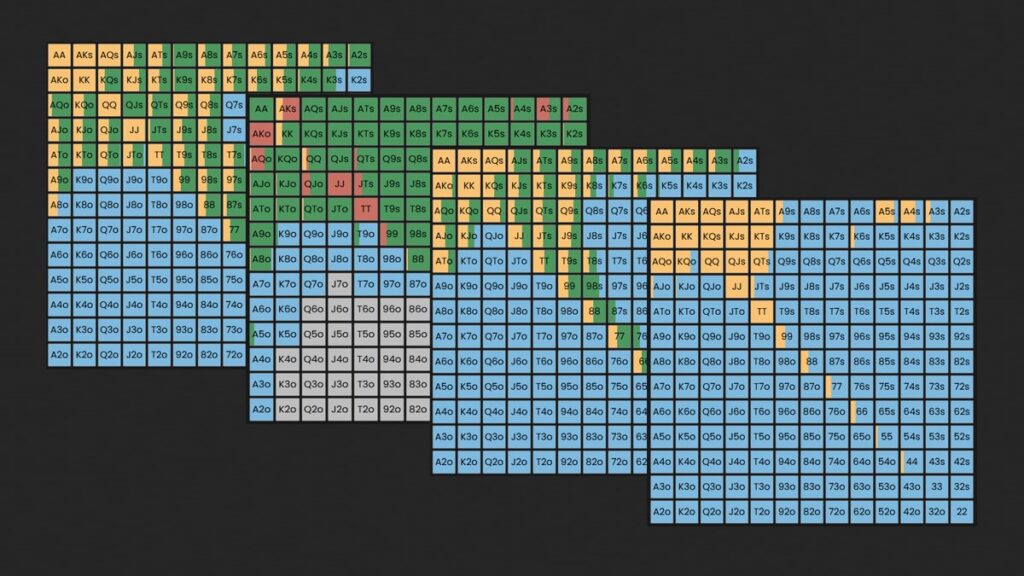
Becoming a good Texas Hold’em player requires building a strong and consistent poker strategy, which always starts with preflop play.
Studying preflop poker charts is the best way to develop a winning strategy, so we analyzed all of the most common situations using advanced poker solvers and sought input from professional poker players to create the ultimate preflop charts.
Our poker charts show which hands you should play from each position and at every stack depth once and for all. We offer free preflop charts for tournaments, online cash games, and live cash game scenarios that you will find on this page:
- 6-max cash games poker charts – 200 big blinds
- 6-max cash games poker charts – 100 big blinds
- GTO preflop charts for tournaments – 80 bb
- GTO preflop charts for tournaments – 30 bb
- Live cash games preflop charts – 200 bb
- Live cash games preflop charts – 100 bb
Depending on the games you play, find the appropriate charts for you and start your studying process today.
GTO Preflop Charts for 6-Max Cash Games
Online cash games are typically played with much deeper stacks, with 100 and 200 big blind scenarios much more common than in tournaments.
With deeper stacks, the solvers recommend playing significantly different poker hand ranges, which is why cash game players should look at the charts below.
200 Big Blind 6-Max Cash Game Preflop Ranges
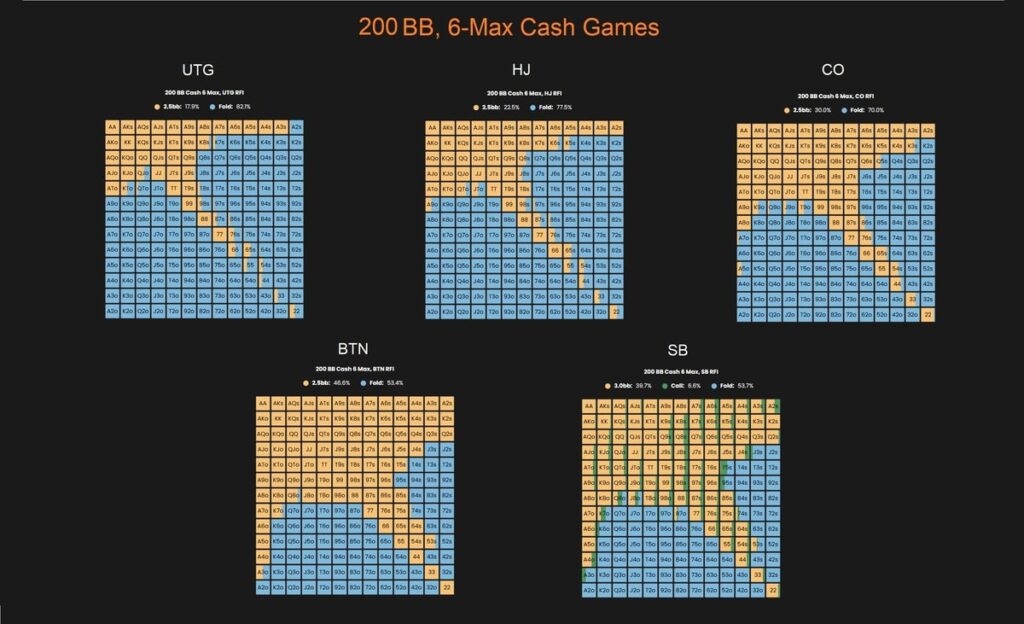
6-max cash games are significantly different than tournaments, especially in terms of average stack depth.
When playing with 200 big blinds, the solvers recommend playing a somewhat tighter opening range from all positions, as indicated below:
- UTG: 66+, A3s+, K8s+, Q9s+. J9s+, T9s+, AT+, KT+, QJ+
- HJ: 55+, A2s+, K5s+, Q8s+, J9s+, T8s+, 98s+, 87s, 76s, 65s, A9+, All Broadways
- CO: 22+, A2s+, K3s+, Q5s+, J7s+, T7s+, 97s+, 86s+, 76s+, 65s+, 54s, A8+, A5, K9+, All Broadways
- BTN: 22+, A2s+, Q2s+, J4s+, T5s+, 96s+, 85s+, 75s+, 64s+, 53s+, A3+, K7+, Q8+, J8+, T8+, 98+
- SB: 22+, Q2s+, J4s+, T6s+, 96s+, 85s+, 75s+, 64s+, 53s+, A4+, K8+, Q8+, J8+, T8+, 98+, 87+
Unlike in tournaments, the 200 big blind cash game chart recommends doing little limping in the small blind and a much tighter starting range.
100 Big Blind 6-Max Cash Game Preflop Ranges
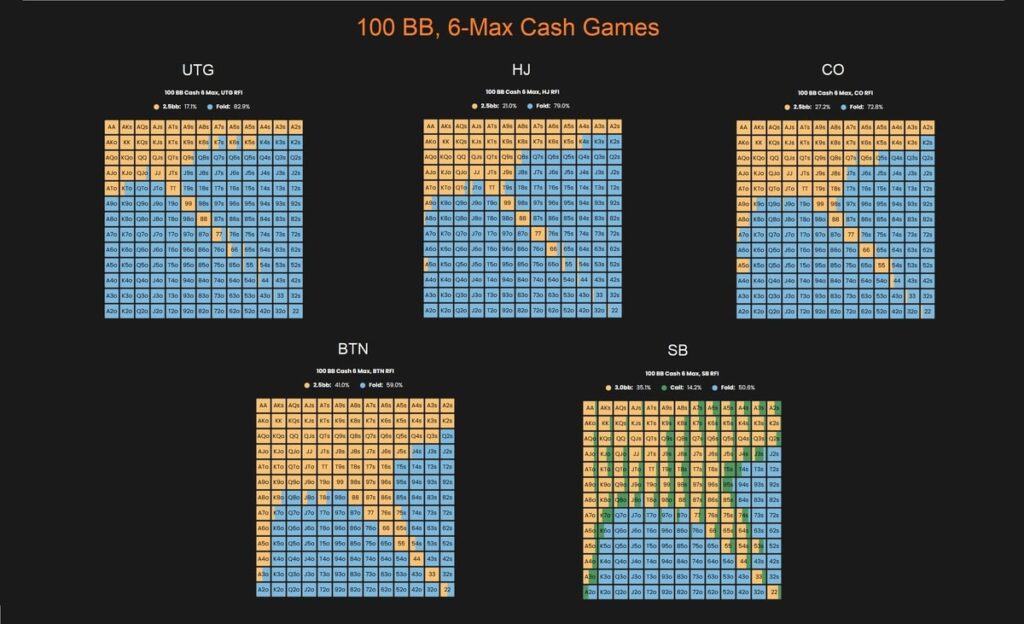
Many online cash games use 100 big blinds as the default starting stack, which is why online players often find themselves playing with 100 big blinds effectively.
In such scenarios, use these cash game preflop charts as your baseline:
- UTG: 77+, A2s+, K5s+, Q9s+. JTs+, AT+, KJ+, QJ+
- HJ: 66+, A2s+, K5s+, Q8s+, J9s+, A9+, KT+, QT+
- CO: 55+, A2s+, K3s+, Q4s+, J8s+, T8s+, 98s+, A8+, A5, KT+, QT+, JT+
- BTN: 22+, A2s+, K2s+, Q3s, J5s+, T6s+, 96s+, 86s+, 75s+, 65s+, 54s+, A3+, K8+, Q9+, J8+, T8+
- SB: 22+, Q2s+, J3s+, T4s+, 95s+, 85s+, 74s+, 64s+, 53s+, A2+, K6+, Q9+, J9+, T9+, 98+,
Note that the differences between 200 and 100 big blind play are not too great. However, it is still worth memorizing the cutoff hands for both and adjusting your ranges as your stack fluctuates throughout the game.
GTO Preflop Charts for Tournaments
Our GTO tournament preflop charts are your perfect solution for preflop play in poker tournaments.
Whether you play online or live poker tournaments, these ranges will help you feel more comfortable with your preflop play and make the right play every single time.
80 Big Blinds Tournament Preflop Ranges
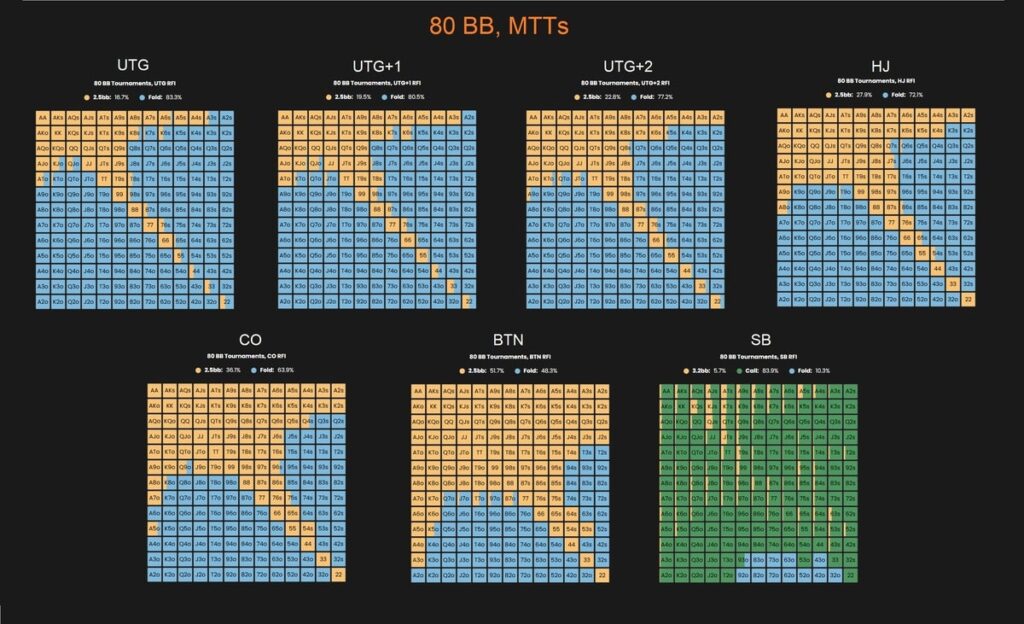
Typically speaking, tournament play leads to shorter stacks across the board, with stacks of over 100 big blinds only common in the early levels.
For that reason, we start with the 80 big blind tournament opening ranges. The next time you are playing in a tournament with close to 80 big blinds, use the following ranges as your opening baseline:
- UTG: 66+, A4s+, K8s+, Q9s+. J9s+, T9s+, AT+, KJ+, QJ+
- UTG+1: 44+, A3s+, K6s+, Q9s+, J9s+, 98s+, AT+, KJ+, QJ+
- UTG+2: 22+, A2s+, K6s+, Q8s+, J8s+, T8s+, 98s+, AT+, KT+, QT+, JT+
- HJ: 22+, A2s+, K4s+, Q7s+, J7s+, T7s+, 97s+, 87s+, A8+, All Broadways
- CO: 22+, A2s+, K2s+, Q4s+, J6s+, T6s+, 96s+, 86s+, 75s+, 54s+, A7+, A5, K9+, J9+, T9+
- BTN: 22+, A2s+, J2s+, T4s+, 95s+, 85s+, 75s+, 53s+, A3+, K5+, Q8+, J8+, T7+, 98+, 87+
- SB: 22+, 32s+, T2+, 93+, 84+, 74+, 64+, 53+
Note that the majority of hands should be played as calls in the small blind, as indicated on the visual representation of the range (green represents call).
When facing a raise from the big blind, you should respond by folding some of your weakest hands, calling with all medium-strength hands, and re-raising with a polar range made up of monsters and bluffing hands like A5s, K4s, and QJ.
30 Big Blinds Tournament Preflop Ranges
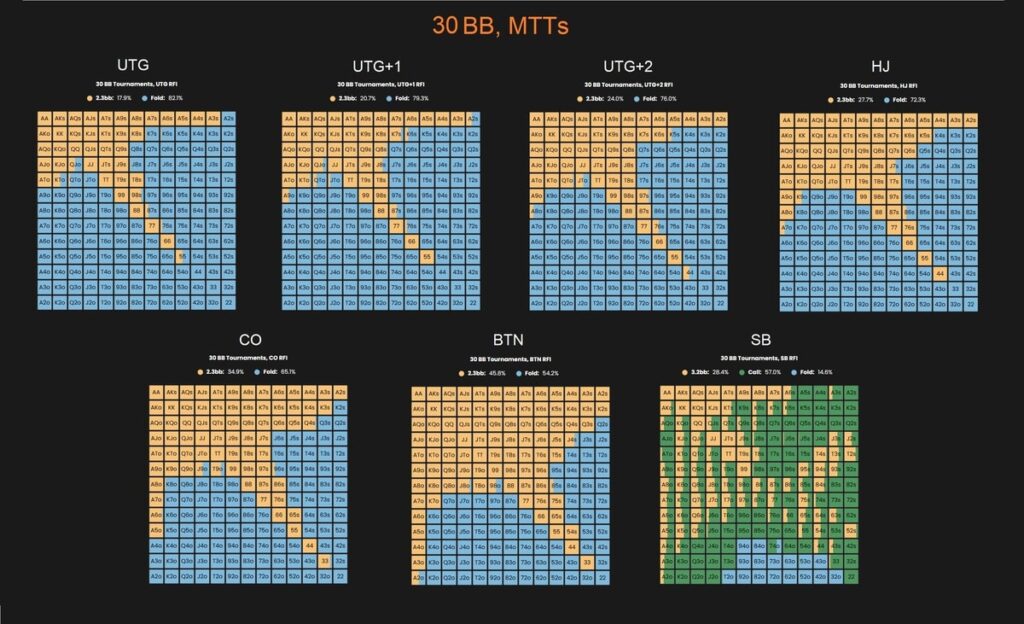
As the tournament goes on, the average stacks get shallower, often leaving you with close to 30 big blinds.
For that reason, the next chart on our list is the tournament preflop chart for 30 big blind play:
- UTG: 55+, A3s+, K8s+, Q9s+. J9s+, T8s+, 98s, AT+, KT+, QJ+
- UTG+1: 55+, A2s+, K7s+, Q8s+, J8s+, T8s+, 98s, A9+, KT+, QT+, JT+
- UTG+2: 22+, A2s+, K6s+, Q8s+, J8s+, T8s+, 98s+, AT+, KT+, QT+, JT+
- HJ: 44+, A2s+, K5s+, Q6s+, J7s+, T7s+, 97s+, 87s+, 76s+ A7+, K9+, All Broadways
- CO: 33+, A2s+, K3s+, Q4s+, J7s+, T7s+, 97s+, 86s+, 76s+, A5+, K9+, J9+, T9+
- BTN: 33+, A2s+, K2s+, Q3s, J4s T5s+, 96s+, 86s+, 75s+, 54s+, A2+, K7+, Q8+, J8+, T8+, 98+
- SB: 22+, 32s+, T3+, 95+, 85+, 74+, 64+, 54+
Much like with 80 big blinds, a good chunk of the small blind range is played as a call. However, note that more raising is recommended with a shallower stack, as indicated on the chart.
When the stacks get even shallower, you might want to adopt a style where you either move all in or fold and for that, we have prepared a full guide on push fold charts.
Poker Preflop Ranges in Full Ring Live Games
Usually played with deeper stacks and nine players per table, live ring games have made a huge comeback in recent years.
If you are a live player or looking to get involved in live cash games, the preflop charts below will give you the much-needed baseline for playing the first betting round in full-ring games.
200 Big Blind Full Ring Live Games Preflop Ranges
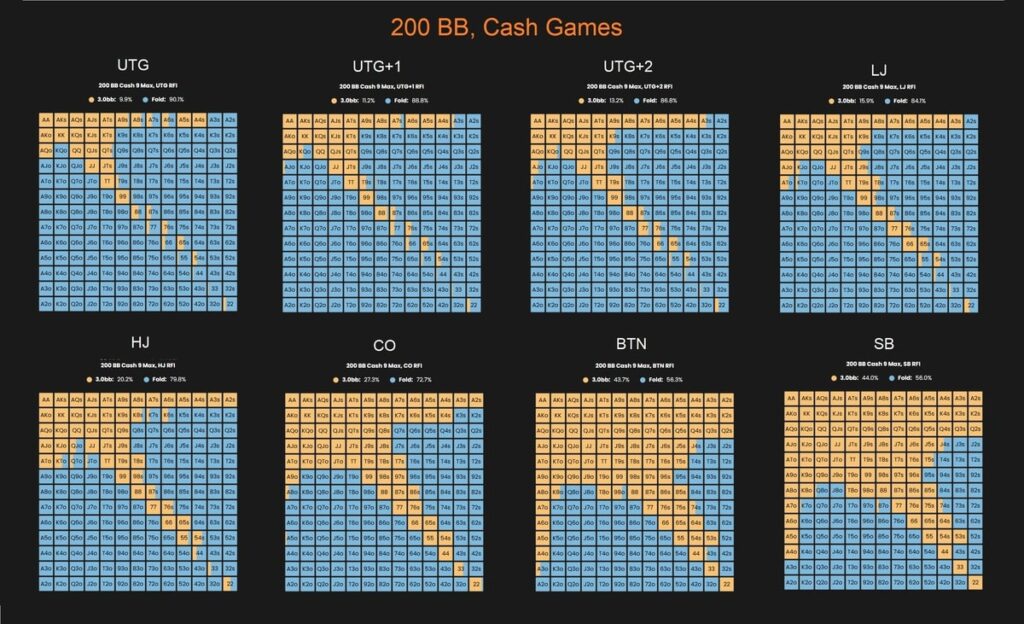
It is very common to see the effective stack at a full-ring live poker table be 200 big blinds or more, which is why 200 big blind ranges are very important.
If you are starting, these are the most important preflop ranges for live cash games you will need to memorize. Make sure to check out the visual representation of the ranges as well, as some of the hands should only be played a portion of the time.
- UTG: 88+, A4s+, JTs, AQ+
- UTG+1: 77+, A4s+, JTs+, AQ+, KQ
- UTG+2: 66+, A3s+, K9s+, JTs+, AJ+, KQ, 87s, 76s, 65s
- LJ: 66+, A3s+, K9s+, QTs+, J9s+, T8s+, 87s, 76s, 65s, 54s, AT+, KQ
- HJ: 55+, A2s+, K8s+, Q9s+, J9s+, T8s+, 98s, 87s, 65s, 54s, AT+, KJ+, QJ
- CO: 22+, A2s+, K4s+, Q8s+, J8s+, T7s+, 97s+, 86s+, 76s+, 65s+, 54s+, A9+, JT+
- BTN: 22+, A2s+, K2s+, Q2s+, J5s+, T5s+, 96s+, 85s+, 75s+, 64s+, 53s+, A4+, K8s+, Q9+, J9+, T8+, 98+
- SB: 22+, A2s+, K2s+, Q2s+, J5s+, T5s+, 96s+, 85s+, 75s+, 64s+, 53s+, A4+, K8+, Q9+, J9+, T8+, 98+
100 Big Blind Full Ring Live Games Preflop Ranges
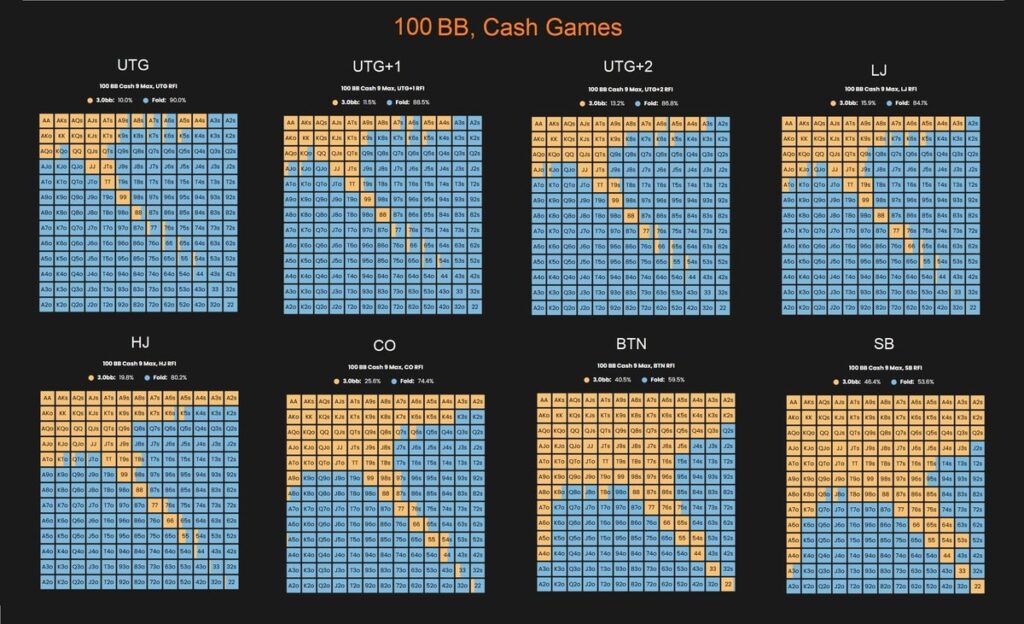
While most live cash games start with well over 100 big blinds per player, it is not uncommon to see 100 big blind stacks, especially at lower stakes.
If you play at your local casino and the stacks are usually a bit shallower, these 100 big blind preflop ranges are the ones you should be focusing on:
- UTG: 88+, A4s+, JTs+, AQ, KQ
- UTG+1: 77+, A4s+, K9s+, JTs+, AJ+, KQ
- UTG+2: 66+, A3s+, K9s+, JTs+, AJ+, KQ
- LJ: 66+, A3s+, K8s+, Q9s+, J9s+, T9s, AT+, KJ+, QJ
- HJ: 55+, A2s+, K6s+, Q9s+, J9s+, T8s+, AT+, KT+, QT+
- CO: 44+, A2s+, K4s+, Q6s+, J8s+, T8s+, 97s+, 87s+, 76s+, 54s+, A9+, JT+
- BTN: 22+, A2s+, K2s+, Q3s+, J5s+, T6s+, 96s+, 86s+, 76s+, 65s+, 54s+, A4+, K8+, Q9+, J9+, T8+
- SB: 22+, A2s+, K2s+, Q2s+, J3s+, T5s+, 96s+, 85s+, 75s+, 64s+, 53s+, A3+, K7+, Q8+, J8+, T8+, 98+
How to Use Preflop Poker Charts
Preflop poker charts among poker odds calculator is among the best learning tools you can have for poker. If you are starting out your poker career, preflop charts will help you improve faster than any other studying tool.
However, it is important to remember that preflop poker charts are just a studying tool and should never be used to cheat.
Learning preflop ranges from preflop hand charts is perfectly acceptable. Using the charts while playing is not!
There is a significant difference between memorizing the charts, knowing which hands to play in every scenario, and using the charts to provide the answers.
If you want to stay in the game for the long run, you should study the charts and remember key ranges. Never use charts while playing, or you may be banned from your favorite poker rooms.
Understanding Hand Ranges
Before you can start applying the knowledge from our preflop hand charts in your game, you need to understand how hand ranges work.
A poker hand range is a collection of hands that you want to play in a certain manner. For example, an opening hand range is a collection of poker hands you should be raising from a certain position at a certain stack depth.
Instead of thinking about what you want to do with your particular hand, you should be thinking in terms of ranges. If the hand you were dealt falls into a certain range, you should act accordingly.
For example, imagine you are dealt QJo in the first position of a full-ring cash game, sitting with a stack of 200 big blinds. The hand seems very playable, and many live players go for a raise without thinking about it.
However, if you refer to the 200 big blind full-ring cash game chart, you will notice this hand does not fall into the opening range and should instead be folded.
If you memorize the appropriate hand ranges for every position and every stack depth, you will know which hands you should play before the cards are even dealt.
This way, you won’t be thinking about what to do once the cards are already dealt but will know which cards fall into your playable range before the dealing starts.
Learning to Read the Charts the Right Way
The various poker charts introduced on this page are the best preflop learning tools you could want, but only if you understand how they work.
Each chart depicts a full hand grid, which is made up of every possible combination of hole cards you can get dealt.
From there, you will notice some of the hands are highlighted in orange while others are highlighted in blue.
The most simple way to interpret the charts is to know that orange hands are the ones you should be raising with, while blue hands are the ones you should be folding.
Note that these charts are only useful if you are the first player into the pot, while a different set of preflop charts shows how to act if another player opens the action in front of you.
Sticking to Fundamentals
Our preflop poker charts depict the most basic preflop strategy for achieving good results against any player pool.
The charts are based on GTO principles, which means they are not designed to exploit any particular player tendencies, nor can any particular strategy exploit them.
By sticking to the fundamentals introduced in these GTO poker charts, you will remain competitive at any poker table, regardless of who your opponents are.
As you progress in your poker career, you will be able to deviate from the poker charts, but the best thing to do when just starting is to stick to the charts and play an optimal raising strategy.
Adjusting to Different Opponents

Once you have mastered the fundamentals and always know your ranges, you can start adjusting them to different opponents.
The moment you deviate from the optimal strategy, you start playing exploitatively, which means you can also be exploited in turn.
However, if not correctly and at the right time, an exploitative strategy can be a great way to increase your win rate and throw your opponents off their game.
Let’s take a look at a few simple examples of how you can adjust the preflop ranges to your opponents.
Adjusting to Tight Opponents
Imagine you are playing in a 6-max cash game online, and your table is playing extremely tight. The two opponents to your left, in particular, are playing very face-up and folding the vast majority of their hands.
What’s even more, they both play very straightforward postflop and don’t try any fancy bluffs. If they don’t hit the flop, they usually fold to your c-bets.
Knowing this gives you a chance to adapt your button opening range and increase your win rate against these players quite significantly.
The 100 big blind 6-max cash game chart suggests some of the weakest hands you should be raising with from the button are A3o, J8o, and 65s.
However, considering how tight the two players in the blinds are, you can easily expand this range to start opening any suited hand and hands as weak as K5o, 85o, and 43o.
Your opponents will fold too much before the flop and give up too easily on the flop, which means you want to play more hands against them and allow yourself as many opportunities to steal pots from them as possible.
Adjusting to Loose Opponents
Now imagine a scenario in which you are also playing in a 6-max cash game online. Your table is very active, with several players to your left 3-betting a ton and defending their blinds very loosely.
In a scenario like this, you can adjust your opening hand ranges by playing tighter, which allows you to have a stronger range when you get 3-bet, or called preflop.
For example, the 6-max preflop chart indicates you should be opening hands like QTo, K5s, and Q8s from the hijack.
Yet, if your opponents are very loose and put a lot of pressure on you preflop, you can adjust by folding these hands and having a tighter range that gets to defend more against 3-bets.
Hands like T9s and 98s might be better suited to calling 3-bets before the flop than hands like QTo and K5s, so you may want to adjust your starting range accordingly. You could also simply play fewer starting hands overall.
Top Tips for Using Preflop Poker Charts
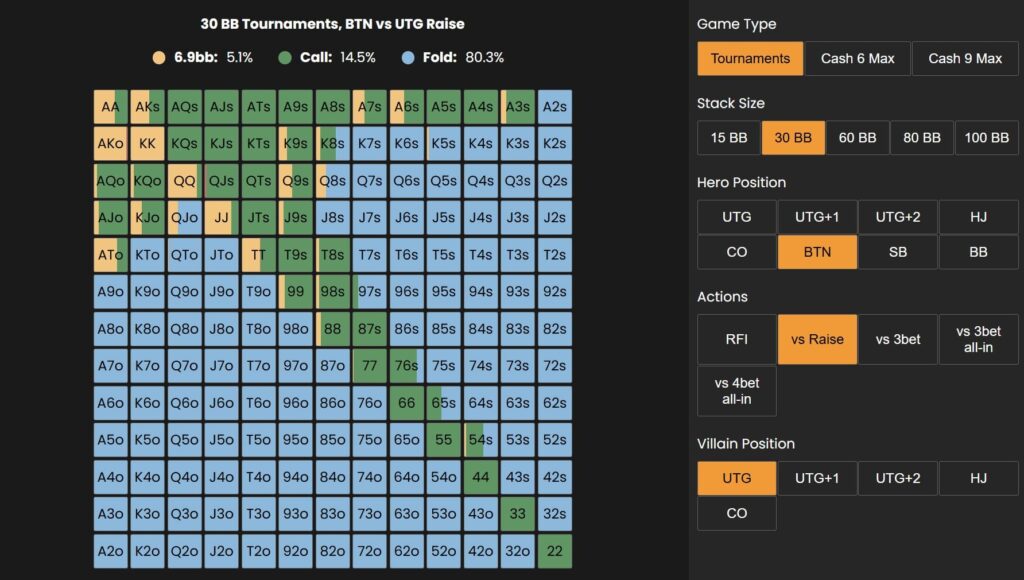
Using preflop hand charts correctly will boost your win rate almost immediately and make you feel more comfortable with every decision you make at the table.
Here are a few useful pro tips for using preflop poker charts that will make them even more effective as learning tools as you move forward.
Use GTO Charts as a Starting Point
The GTO poker strategy is designed for perfect balance. It aims to be unexploitable in all situations, which means it works well against any opponent.
However, there is no reason to always stick to GTO poker 100% and never make any adjustments to your opponents’ playing styles.
Instead, always be observant at the tables and make adjustments to particular opponents and population tendencies alike.
In all of this, use the GTO charts as your starting point. Whenever you decide to deviate, remember your baseline and take a few steps away from it to improve your strategy against your particular opponents.
Group the Hands to Remember Them Easier
The best way to memorize preflop hand charts is by grouping hands together. This makes the ranges much easier to remember.
For example, in the 6-max cash game ranges, it is indicated that the hijack should be opening every suited ace from AKs to A2s. By simply remembering “all suited aces,” you save yourself the trouble of memorizing 12 different hands.
A technique used by all professional poker players is to remember the cutoff hands, which are the weakest hands in different categories that fall into a hand range.
For example, when learning the button range for 100 big blind play in cash games, simply remembering K2s, Q3s, J5s, and 54s allows you to easily memorize all the suited hands you should be opening.
By knowing the cutoff hands, you can easily extrapolate which other hands in the given hand category belong in the range.
Avoid Common Mistakes
Poker players tend to make the same mistakes repeatedly when using preflop hand charts.
The first mistake is thinking that you have to always play in perfect sync with the charts and that deviating from them is a huge mistake.
The truth is that raising the hand that’s one below the cutoff or folding the actual cutoff hand will not impact your win rate all that much.
For example, if a chart suggests you should raise 44 but fold 33, this doesn’t mean you will be losing heaps by opening 33. Conversely, folding 44 in the same scenario won’t be a terrible loss, either.
As long as you are able to remember the charts for the most part and not unintentionally deviate from them too much, you will be just fine.
Another common mistake is never deliberately deviating from the charts. As discussed earlier, you should definitely adjust your strategy based on your opponents and deviate from the GTO strategy to maximize your win rate.
Don’t fall into the trap of forcing yourself to play perfect GTO ranges at all times, and use logic and deduction to figure out profitable spots in which to deviate from optimal play.
Summary – Why You Should Use GTO Charts as Your Baseline
The GTO poker strategy is based on pure math and is designed to be unexploitable, making it the best approach for new players.
By learning the GTO poker charts presented here, you will have the perfect baseline for all scenarios. The ranges you learn here can be your starting point for all adjustments you make in the future.
Once you are comfortable enough, you can start making particular adjustments to your strategy based on the opponent’s tendencies with the goal of exploiting their weaknesses.
However, remember that you can’t really deviate from something you don’t understand, so make sure to learn the basic pre-flop charts before using any exploitative strategies and check our poker cheat sheet.